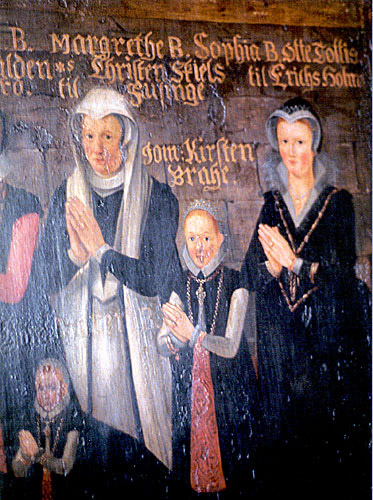| Sophie Brahe

| | Sophie Brahe var som sin bror alsidigt begavet og interesseret som et typisk renæssancemenneske.
Kendt for eftertiden er hendes studier i danske adelsslægter, men hun interesserede sig også levende for lægekunst, fremstillede selv medicinske præperater og sendte i 1625 recept på en pesteleksir til kongen.
Endvidere dyrkede hun både astrologi og astronomi og havekunst. |
En renæssancekvinde
Da Charles Ogier i 1634 forlader Helsingør beretter han også, at han på vejen møder Tycho Brahes søster Sophie, som på det tidspunkt er sidst i 70erne. Hun havde altså da overlevet sin berømte bror med over 30 år, og havde ifølge det ældste kendte vidnesbyrd boet i Helsingør siden 1626.
Sophie Brahe var, som sin bror, alsidigt begavet og interesseret som et typisk renæssancemenneske. Kendt for eftertiden er hendes studier i danske adelsslægter, men hun interesserede sig også levende for lægekunst, fremstillede selv medicinske præperater og sendte i 1625 recept på en pesteleksir til kongen. Endvidere dyrkede hun både astrologi og astronomi og havekunst.

Brahe familien | 
Sophie Brahe | 
Mindetavle |
Sophie Brahes havekunst
Desværre kender vi intet nærmere til Sophie Brahes havekunst, som broderen berømmer. Hun har formodentlig hjulpet sin broder med haven på Hven, men også dyrket sin egen have på godset Eriksholm i Skåne og siden hen i Helsingør, hvor hun ejede en byejendom med tilliggender i udkanten af byen og tæt ved Kronborg.
Et brev til den svenske adelsmand Johan Sparre fra d.14. september 1629 vidner dog om hendes kundskaber. Første del af brevet handler om slægtsforskning, hvor Sophie har lånt og korrigeret nogle slægtstavler. Herefter skriver Sophie Brahe om blomsterløg og giver en anvisning på, hvordan de skal behandles.

Kejserkrone | 
Renæssancehave | 
Haveudsnit |
Renæssancehavens ide.
Uranienborgs haveanlæg var, som det fremgår af samtidige stik, et kvadratisk anlæg præget af symmetri ned i mindste detaljer. Det yderste bælte bestod af, sandsynligvis, frugttræer, som omgiver den indre del med de geometrsik udformede bede, som har rummet både nytte- og prydplanter. Overgangen imellem de to dele er markeret med fire ens lysthuse.
Uranienborgs have er speciel med den gennemførte symmetri, som formodentlig refererer til det samlede anlæg karakter af videnskabs- og forskningscenter. I denne forstand lever haven fuldt ud op til renæssancehavens ide: Den skal adsprede, men også udfordre og stimulere den besøgendes nysgerrighed og anspore til intellektuel og åndelig fordybelse. Det behagelige kombineres med det nyttige, - hvilket havens beplantning også vidner om.

Florens 1545 | 
Nortons botaniske værk 1597 | 
Kvan 1597 | 
Lavendel 1597 | 
Tulipan 1561 |
|